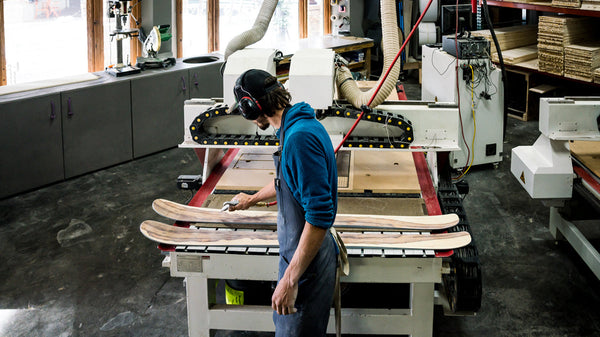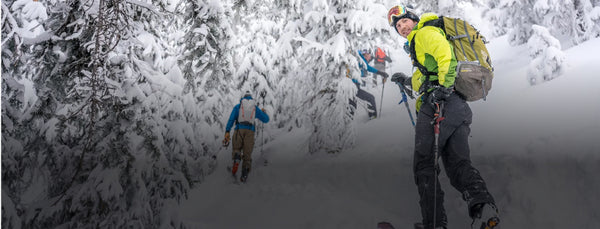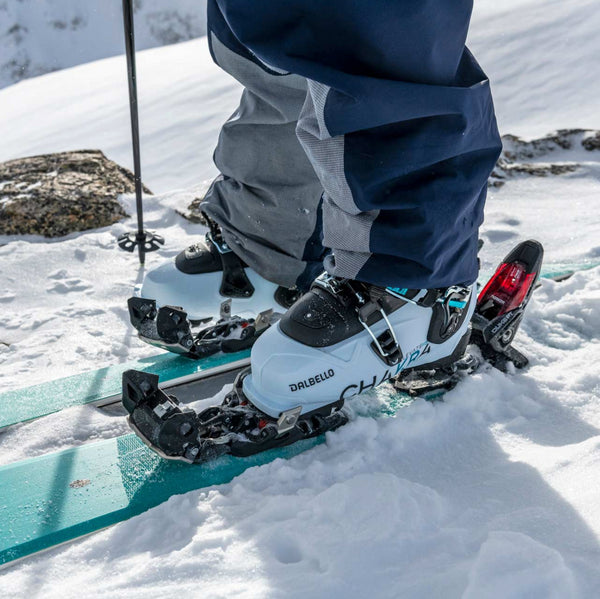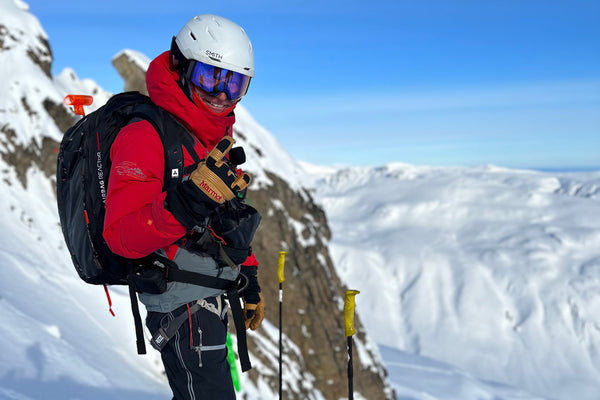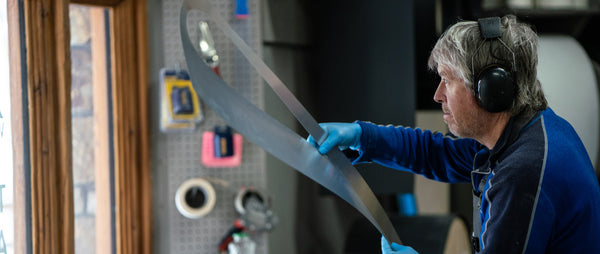
How to Save Spring Snow
If you’ve ever skied the Rocky Mountains in the spring, you’ve surely noticed a layer of reddish-brown dust on the top of the snowpack.
That dust may seem benign, a natural phenomenon precipitated by the windy spring season. But—shocker—it’s mostly caused by us, and it’s wreaking havoc on our snowpack, our water reservoirs, our wildfire season, and our mountain ecosystems as a whole.

In this snowpit, you can see three distinct dust events (and another two-to-four lesser events). Photo: snowstudies.org
Dust has become a problem all over the world—in the Himalaya, the Alps, the Andes... But for those of us who ski in the Rockies, the dust comes from places we are likely familiar with. Come spring and fall, we skiers load our cars up with mountain bikes, tents, and coolers of beer and head to Moab, Fruita, Sedona, St. George, Salida, Penitente, and even Las Vegas for a long weekend of extra warmth and riding through some of the most scenic terrain in the world. We soak it all in—the rock formations, the flowering cacti, the languid green rivers. But you know what we never notice? The most important part of the desert ecosystem: the organisms under our feet.

Bio crust. Photo courtesy of Neal Herbert, NPS
Most of us look out on the desert landscape and think the only vegetation is the cacti and sagebrush poking out of the sand. But in between it all is the glue that literally holds it all together—the biocrust. To the untrained eye, it might look like clumps of dark dirt, a sort of colorless moss, easy to tread over without a second thought. But upon closer investigation, it is a diverse rainbow of incredible organisms—bacteria, lichens, and mosses—that live on the top few centimeters of the desert’s surface.
“Without these coverings over the soil, there’s nothing to hold the sand under the surface,” said Kristina Young, adjunct assistant professor at the Wildland Resource Department of Utah State University and founder of Science Moab. “They glue the soil surface together and create a stable base.”
This biocrust is extremely hardy, with incredible adaptations that allow it to survive where not much else can. It withstands extreme temperatures—from 0 to 110 degrees Fahrenheit—and severe drought. “Most of the time it’s in a desiccated dormancy, but once it rains, the desert comes alive and all the lichens and moss get larger and some turn green,” Young said. “It’s super beautiful—a whole community of living things.”
Yet this biocrust, like most living things, has an Achilles’ heel—a weakness that’s almost too exposed to believe. “These really badass organisms are able to live in Moab when it’s 105 degrees,” Young said, “but they are super vulnerable to compression.”

A trail works its way through the desert. Stay on well-used trails and avoid veering off-path.
So what is compression, and what causes it? “Anything that disrupts the soil in the desert,” Young said. These tender organisms are simply crushed by anything or anyone that treads on them. Chief offenders are cattle, oil drilling operations, cultivation, and roads. But second to that are off-road ATV travel, dispersed camping, and even people walking or biking off the trails. “It’s all of these things combined.”
Once the living crust is disturbed, it dies, leaving the undersoil defenseless and untethered. “Prevailing winds from the desert in the Southwest move toward the Rocky Mountains,” Young said. “So, when the soil gets disturbed, it gets taken up into the atmosphere and keeps getting blown until it hits the next tallest thing, which in our case is the Rockies.”

Not the Rockies, but a well-documented event in Spain where Sahara dust blew into the mountains.
The effects of the disturbed earth are well documented. First of all, the blowing dust is actually erosion of desert soil, which strips the landscape of nutrients that the plants and animals there need to survive. And when it is blown by springtime winds into the snowpack, the white snow picks up color and loses its albedo, a measure of reflected radiation. The snowpack instead absorbs the sun’s heat and melts faster, causing early spring runoff (and shortening couloir season for backcountry skiers).
The early runoff makes reservoirs fill too fast, resulting in the premature release of water before the demand for it is high and subsequently diminishing reserves for summer. The increased speed of the spring runoff also lessens the absorption of snowmelt by the alpine soil, as the water just cascades downhill rather than slowly trickling down into the earth. The newly bare earth, in turn, causes alpine plants to bloom early, which then pull water out of the earth and into the atmosphere during photosynthesis. “There’s a net loss of water in these mountain systems that comes from losing water earlier in the year,” Young said.
Young first became fascinated by the biocrust when she visited Moab on spring break from the University of Montana, where she got her undergrad degree. “I was introduced to these crazy organisms that nobody ever told me existed,” she said. “Here we were, in the desert, and there was this weird colorful something covering the soil. I got really interested in learning how the desert places work and how these large communities of living organisms survive in such a challenging place. … It’s like the coral reef of the desert.”

Desert dust on Vail's snowpack, as captured by their webcam in 2021.
The erosion of these delicate landscapes is not a new phenomenon. Livestock grazing on both public and private land began in earnest before the turn of the 19th century, after President Abraham Lincoln signed the Homestead Act. (Remember learning about the Dust Bowl in history class? Same situation—different time.) “Herds of animals caused immense amounts of soil erosion,” Young said. “Dust bowl landscapes were heavily disturbed within the last century. They lost a lot of their resilience and plants that stabilize soil. In these dry places, it takes a long time to recover.”
“We have learned a thing or two from our history—we’re working toward limiting grazing, setting restrictions in place for what areas can be developed for oil and gas, and what ones can be used for recreation." But it’s not enough. “We’re still asking a lot of these places,” Young said.
So what, then, can we regular people do? For starters, awareness is key, Young said. Once people understand the delicate balance of these fragile ecosystems, they’ll be far less likely to take their cars or ATVs or mountain bikes off-trail or off-road. The more people understand, the more they will think about sustainable use for grazing, too. “It’s going to require collective effort and commitment to prioritize what places we need to set aside,” Young said. “If we keep losing this topsoil, we’ll be left with sand dunes.”

A cactus blooms after a spring rain. Bio crust surrounds the plant.
This desert season, when you’re biking and camping and drinking beer out of your cooler, Young has a favor to ask. “Really look at the soil surface,” she said. “It’s an immensely cool, beautifully evolved community. Start by seeing deserts differently—they’re so full of life if you know how to look for it. Reimagine it in your mind as a place that has a lot of ecological importance. And when you visit, you might decide to not disturb the crust or create a new dispersed campsite. It’s about being mindful.”
Which, of course, is always the answer. To pretty much everything.
For more information or to learn how you can help, visit sciencemoab.org.
--
Article by Kimberly Beekman
Kimberly Beekman is the former editor-in-chief of the late, great Skiing Magazine (RIP), and a longtime editor of SKI Magazine before that. She currently uses the title of “freelancer” as a beard to ski powder all over the world. She lives in Steamboat, Colorado, with her wonderful daughter and terrible cat.

